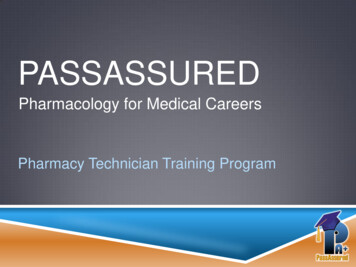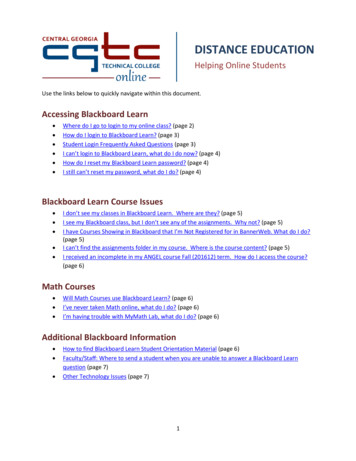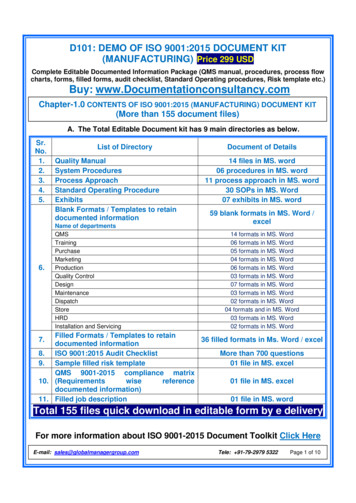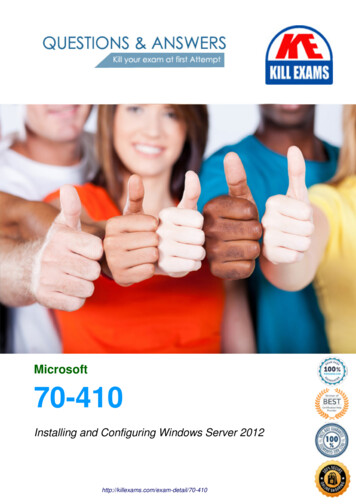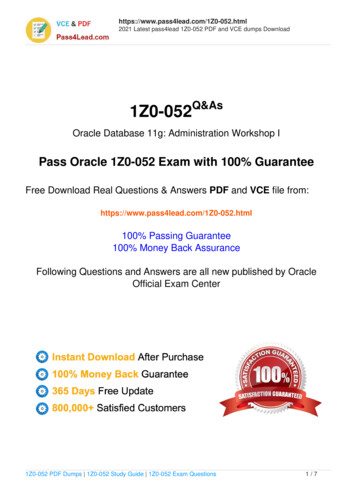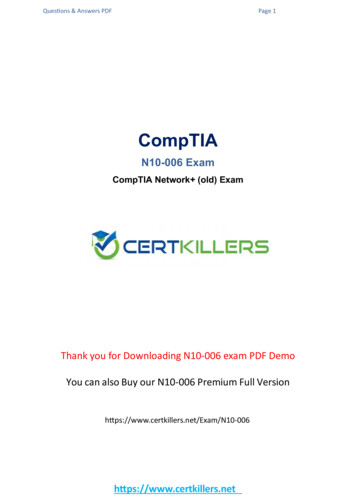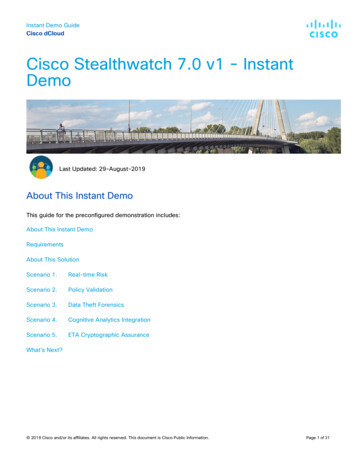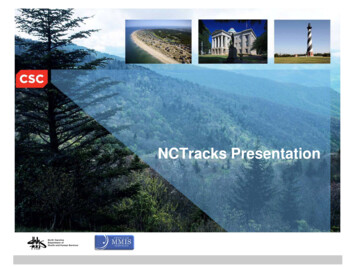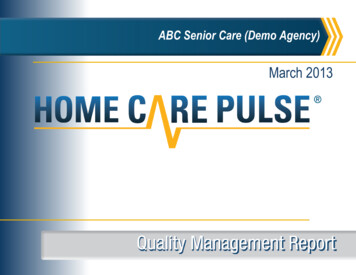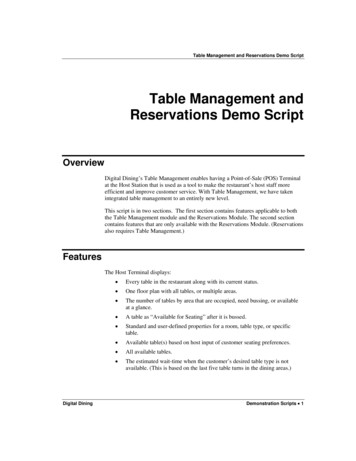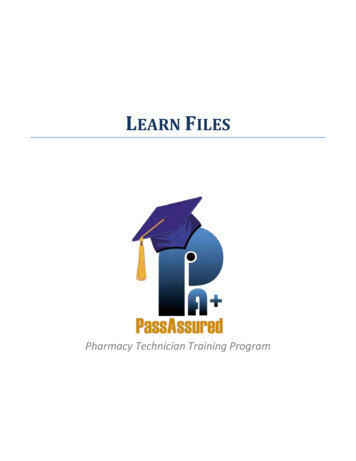
Transcription
LEARN FILESPharmacy Technician Training Program
This page intentionally left blank. Pass Assured, LLC Version 19.hPage 1
Table of ContentsTable of Contents . 2SECTION: ORIENTATION. 5Orientation Sub-Section 2: Exams and Re-Certification . 6Two Nationally Known Certifying Organizations . 6For purposes of the national certifications . 7The Re-Certification Process. 8Audits . 9SECTION: FEDERAL LAW. 10Federal Law Sub-Section 3: Rules of Controlled Substances . 11Recordkeeping Requirements . 11Required Records. 11Prescription Records . 12SECTION: MEDICAL REVIEW . 14Medical Review Sub-Section 6: Cardiovascular Drugs . 15Cardiovascular System . 15Cardiac Glycosides . 15Antiarrhythmics . 16Antianginals . 16Vasodilators . 17Endothelin Receptor Antagonists . 17Phosphodiesterase Type 5 Inhibitor (PDE-5). 17Calcium Channel Blockers. 18Angiotensin-Converting Enzyme (ACE) Inhibitors . 19Angiotensin II Receptor Blockers (ARB) . 20Renin Inhibitors . 21Beta-Adrenergic Blockers . 21Selective Alpha-2 Adrenergic Agonist . 22Alpha-Adrenergic Blockers . 22Alpha/Beta-Adrenergic Blocking Agents . 22Antilipidemic Agents . 23SECTION: ASEPTIC TECNIQUE . 25Page 2 Pass Assured, LLC Version 19.h
Aseptic Technique Sub-Section 4: Techniques for Sterile Compounding . 26Prior to Compounding . 26Working in a Laminar Air Flow Hood . 26Prevent Shadowing . 26Location of Sterile Room . 27Personnel Precautions . 27Withdrawing Liquid from a Vial . 27Withdrawing Liquid from an Ampule . 27Reconstituting a Sterile Powder in a Vial . 28Introduce Liquid into a Plastic IV Bag . 28Introducing Liquid into a Glass IV Bottle . 28Places to Avoid Touching or Blocking Air Flow during Preparation . 29Visual and Quality Control Inspection of Parenteral Products . 29Components of a Parenteral Product Label . 29SECTION: CALCULATIONS. 30Calculations Sub-Section 2: Abbreviations. 31Abbreviations. 31Abbreviations Commonly Used in Prescriptions and Medication Orders . 31Abbreviation Errors . 35Abbreviations, Symbols, or Syntax that Should be Avoided . 35SECTION: PHARMACY OPERATIONS . 36Pharmacy Operations Sub-Section 4: USP Chapter 795 – Nonsterile Preparations . 37Definitions. 37Three General Categories of Non-Sterile Compounding. 38Responsibility of the Compounder . 39Definitions: . 40Controlled Substances: . 41Compounding Documentation . 42Compounding Required Records . 42Preparation of Ointments . 42Methods of Ointment Preparation . 43Preparation of Suppositories . 44 Pass Assured, LLC Version 19.hPage 3
Methods of Suppository Preparation . 44Preparation of Emulsions . 45Methods of Emulsion Preparation . 46Preparation of Enemas . 48Preparation of Solutions . 48Preparation of Syrups . 49Page 4 Pass Assured, LLC Version 19.h
SECTION: ORIENTATION Pass Assured, LLC Version 19.hPage 5
Orientation Sub-Section 2: Exams and Re-CertificationTwo Nationally Known Certifying Organizations1) The National Healthcareer Association (NHA) offers the Exam for Certifying PharmacyTechnicians (ExCPT)2) The Pharmacy Technician Certification Board (PTCB) offers the Pharmacy TechnicianCertification Exam (PTCE)Make sure to visit your state’s board of pharmacy website to find out which exam is a requirement.Many states will accept either exam.NHAOrganizations endorsing the ExCPT include: American Association of Pharmacy Technicians National Alliance of State Pharmacy Associations National Organization for Competency Assurance National Pharmacy Technician Association Northwest Career Colleges Federation Pharmacy Technician Educators CouncilMission StatementThe mission of ExCPT is to recognize pharmacy technicians who are proficient in the knowledge andskills needed to assist pharmacist to safely, accurately and efficiently prepare and dispenseprescriptions, and to promote high standards of practice for pharmacy technicians.Requirements to sit for this exam: Be at least 18 years of age Have a high school diploma or the equivalent Have successfully completed a training program OR have a minimum of 12 months ofpharmacy-related work experience within the last 36 months.*Please Note: PassAssured is an NHA accepted program and meets the requirements for a trainingprogram.PTCBEstablished in January 1995Four Founding Organizations: American Pharmacists Association (APhA) American Society of Health-System Pharmacists (ASHP) Illinois Council of Health-System Pharmacists (ICHP)Page 6 Pass Assured, LLC Version 19.h
Michigan Pharmacists Association (MPA)Mission StatementPTCB develops, maintains, promotes, and administers a nationally accredited certification andrecertification program for pharmacy technicians to enable the most effective support of pharmaciststo advance patient safety.GoalsThe PTCB was founded to create one consolidated voluntary national certification program forpharmacy technicians. It is responsible for the development and implementation of policies related tovoluntary national certification for pharmacy technicians.Requirements to sit for this exam: High school diploma or equivalent education diploma (e.g. a GED or foreign diploma) Full disclosure of all criminal and state board of pharmacy registration or licensure actions*Please Note: PassAssured is a PTCB approved program and meets the requirements for a trainingprogram.Both national exams are accredited by the National Commission for Certifying Agencies also known asthe NCCA. The NCCA was created in 1987 by the Institute for Credentialing Excellence. Its main goalwas to help ensure the health, welfare, and safety of the public through the accreditation of a varietyof certification programs that assess professional competence.For purposes of the national certifications, pharmacy technicians are defined as individualsworking in a pharmacy, who under the supervision of a licensed pharmacist, assist in pharmacyactivities not requiring the professional judgment of the pharmacist.Both exams sample the candidates’ knowledge and skill base for activities performed in the work ofpharmacy technicians. Functions and responsibilities of pharmacy technicians may be specificallydefined by state rules and regulations as well as job-center policies and procedures.The pharmacy technician is accountable to the supervising pharmacist, who is legally responsible byvirtue of state licensure for the care and safety of patients served by the pharmacy. The pharmacytechnician performs activities as the result of having certain knowledge and skills.Not every state requires national certification; pharmacy technicians who receive certification aremore marketable. Individuals can work as a pharmacy technician part or full-time, allowing forexperience and income while studying to become a pharmacist, Emergency Medical Technician, nurse,doctor, or a variety of other fields in the medical profession. Pharmacy technicians can also move on tobecome a pharmaceutical representative. Pass Assured, LLC Version 19.hPage 7
Pharmacy technicians who further their training with nuclear or IV certifications can find work in moreadvanced pharmacies or hospitals, potentially with better pay. Pharmacists can become specialized innuclear pharmacy, become a consulting or clinical pharmacist, be a diabetic specialist, or havecredentials with medication therapy management (MTM). There are a myriad of career paths that havethe ability to stem from becoming a pharmacy technician.The Re-Certification Process Renewal of certification is required every two years. Re-certification fees are set by the NHA and the PTCB. Continuing Education (CE) must be pharmacy technician specific.To recertify for ExCPT through NHA:The technician must complete 20 hours of continuing education. To view what the 20 hours mustinclude, please view NHA’s website at www.nhanow.com.Additional CE credits will not carry over to the next two year period. You must complete the 20 hoursrequired within that time period.All technicians have a 90 day grace period after their certification expires to recertify.If a technician fails to recertify past the 90 day grace period, the technician will lose their certificationstatus.Again, visit NHA’s website for the forms to fill out and the proper procedure to recertify.To recertify for PTCE through PTCB:CPhTs can apply for recertification 100 days prior to the expiration date.Application should be submitted at least 30 days prior to certification expiration date and must beonline unless otherwise requested in writing.Failure to recertify: certified pharmacy technicians that fail to recertify by midnight EST on the date ofthe certification expiration are no longer certified by the PTCB. They must immediately stop using thetitle CPhT.Reinstatement: to apply for reinstatement, visit the NHA or PTCB website for instructions - whomeveryour certification is through.Continuing Education (CE) Guidelines Twenty (20) contact hours of continuing education required for re-certification. Please refer to NHA website and PTCB website for a list of all accepted topics. Hours must be earned within the two-year period. Requirements must be completed on or before the certification expiration date.Page 8 Pass Assured, LLC Version 19.h
No continuing education hours earned before passing the ExCPT exam or PTCB exam may beused for recertification.Extra hours earned during any two-year certification period may not be carried over and applied to thenext certification period requirements.AuditsA certain number of CPhTs will be chosen at random for an audit of continuing education by thePharmacy Technician Certification Board (PTCB) and National Healthcareer Association (NHA).If chosen for an audit, the CPhT must observe all requirements and upload or submit copies of thecontinuing education documentation as instructed. If you choose to not comply with the auditinstructions, your certification will not be renewed and you will no longer be able to use the titlecertified pharmacy technician.All continuing education documentation should be kept for at least one year beyond the expirationdate of each certification period.There are different sources where you can obtain continuing education credits. For a list of where toobtain continuing education credits, visit the PTCB’s or NHA’s websites.Return to top of Orientation Sub-Section 2: Exams and Re-CertificationReturn to Table of Contents Pass Assured, LLC Version 19.hPage 9
SECTION: FEDERAL LAWPage 10 Pass Assured, LLC Version 19.h
Federal Law Sub-Section 3: Rules of ControlledSubstancesRecordkeeping RequirementsEvery pharmacy must maintain complete and accurate records on a current basis for each controlledsubstance purchased received stored distributed dispensed or otherwise disposed ofThese records are required to provide accountability of all controlled substances starting with themanufacturing process, to the dispensing pharmacy and to the patient. The potential for diversion ofcontrolled substances is reduced using this closed system. All required records concerning controlled substances must be maintained for at least twoyears for inspection and copying by duly authorized DEA officials.Records and inventories of schedule II controlled substances must be maintained separatelyfrom all other records of the registrant.All records and inventories of schedules III, IV, and V controlled substances must be maintainedeither separately from all other records or in such a form that the information required isreadily retrievable from the ordinary business records.Required Records1. The records which must be maintained by a pharmacy are:2. Executed and unexecuted official order forms (DEA Form 222) or the electronic equivalent3. Power of Attorney authorization to sign order forms4. Receipts and/or invoices for schedules III, IV, and V controlled substances5. All inventory records of controlled substances, including the initial and biennial inventories,dated as of beginning or close of business6. Records of controlled substances distributed (i.e., sales to other registrants, returns to vendors,distributions to reverse distributors)7. Records of controlled substances dispensed (i.e., prescriptions, schedule V logbook)8. Reports of Theft or Significant Loss (DEA Form 106), if applicable9. Inventory of Drugs Surrendered for Disposal (DEA Form 41), if applicable10. Records of transfers of controlled substances between pharmacies11. DEA registration certificate12. Self-certification certificate and logbook (or electronic equivalent) as required under theCombat Methamphetamine Epidemic Act of 2005 Pass Assured, LLC Version 19.hPage 11
Prescription RecordsPharmacies have two options for filing paper prescription records under the Code of FederalRegulations (C.F.R.). All prescription records must be readily retrievable for DEA inspection. Controlledsubstance prescriptions must be filed in one of the following w
2) The Pharmacy Technician Certification Board (PTCB) offers the Pharmacy Technician Certification Exam (PTCE) Make sure to visit your state’s board of pharmacy website to find out which exam is a requirement. Many states will accept either exam. NHA Organizations endorsing the ExCP

